
|
Navigate |
| Home |
| Kirstie Alley |
| Our 30th Anniversary |
| Never Turning Back |
| Narconon Endorsements |
| |
|
|
| |
|
|
| |
|
Facts About Drugs |
| FAQ About Ambien |
| FAQ About Ativan |
| FAQ About Cocaine |
| FAQ About Codeine |
| FAQ About Crack |
| FAQ About Darvocet |
| FAQ About Dexedrine |
| FAQ About Demerol |
| FAQ About Dilaudid |
| FAQ About Ecstasy |
| FAQ About GHB |
| FAQ About Heroin |
| FAQ About Hydrocodone |
| FAQ About Ketamine |
| FAQ About Lortab |
| FAQ About LSD |
| FAQ About Marijuana |
| FAQ About Morphine |
| FAQ About Meth |
| FAQ About Methadone |
| FAQ About Opiates |
| FAQ About Opium |
| FAQ About Oxycontin |
| FAQ About Percocet |
| FAQ About Percodan |
| FAQ About Ritalin |
| FAQ About Rohypnol |
| FAQ About Ultram |
| FAQ About Valium |
| FAQ About Vicodin |
| FAQ About Xanax |
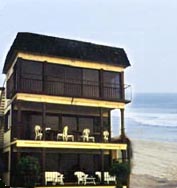 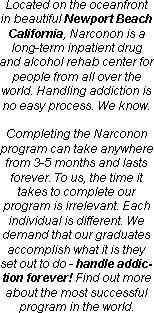 |
|
Resources |

|


 Print this article |  Send this article to a friend |  Add to Favorites |
FAQ
About LSD
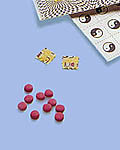
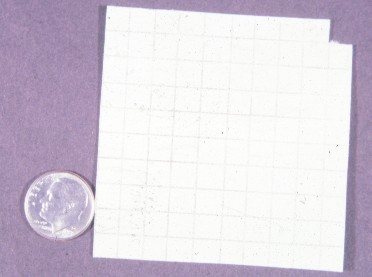 Q)
What is LSD?
Q)
What is LSD?
A) LSD (d-lysergic acid diethylamide), commonly called "acid," was discovered in 1938 and is the most powerful known hallucinogen - a drug that radically changes a person's mental state by distorting the perception of reality to the point where, at high doses, hallucinations occur. Although it is derived from a fungus that grows on rye and other grains, LSD is semi-synthetic. It is chemically manufactured in illicit laboratories, except for a small amount which is produced legally for research.
Q) What does LSD look like and how is it used?
A) LSD, commonly referred to as "acid," is sold on the street in tablets, capsules, and, occasionally, liquid form. It is odorless, colorless, and has a slightly bitter taste and is usually taken by mouth. Often LSD is packaged in capsules, tablets, or solutions, or spotted on to gelatin sheets or pieces of blotting paper, with each square representing one dose.
Q)
What are the effects of LSD?
A) The effects of LSD are unpredictable.
They depend on the amount taken; the user's personality, mood, and expectations;
and the surroundings in which the drug is used. Usually, the user feels the first
effects of the drug 30 to 90 minutes after taking it.
Sensations
and feelings change much more dramatically than the physical signs. The user may
feel several different emotions at once or swing rapidly from one emotion to another.
If taken in a large enough dose, the drug produces delusions and visual hallucinations.
The user's sense of time and self changes. Sensations may seem to "cross
over," giving the user the feeling of hearing colors and seeing sounds. These
changes can be frightening and can cause panic.
Users
refer to their experience with LSD as a "trip" and to acute adverse
reactions as a "bad trip." These experiences are long - typically they
begin to clear after about 12 hours.
Appearing
first are physical effects including: numbness; muscle weakness and trembling;
rapid reflexes; increased blood pressure, heart rate, and temperature; impaired
motor skills and coordination; dilated pupils; and, occasionally, nausea and seizures.
One of most noticeable signs is laughter, often at things that aren't particularly
funny and often uncontrollable.
Dramatic changes in perception, thought, and mood occur shortly after the physical effects. These may include:
- vivid, usually visual, "pseudo-hallucinations" that the user is aware are not real
- distorted perceptions of: time (minutes seem like hours); distance (hazardous if operating motor vehicles or standing near balcony edges); gravity (sensations of floating or being pressed down); the space between oneself and one's environment (for some, a feeling of oneness with the universe, for others, a feeling of terror)
- fusion of the senses (music is "seen," colors "heard")
-
diminished control over thought processes, resulting in recent or long-forgotten
memories resurfacing and blending with current experience, or in insignificant
thought or objects taking on deep meaning
Q)
What are the side effects of LSD use?
A)
The side effects of LSD are: dilated pupils, higher body temperature, increased
heart rate and blood pressure, sweating, loss of appetite, sleeplessness, dry
mouth, and tremors.
Some
LSD users experience severe, terrifying thoughts and feelings, fear of losing
control, fear of insanity and death, and despair while using LSD. Some fatal accidents
have occurred during states of LSD intoxication.
Many
LSD users experience flashbacks (visual images ranging form formless colors to
frightening hallucinations), without the user having taken the drug again. A flashback
occurs suddenly, often without warning, and may occur within a few days or more
than a year after LSD use. Flashbacks usually occur in people who use hallucinogens
chronically or have an underlying personality problem; however, otherwise healthy
people who use LSD occasionally may also have flashbacks. Bad trips and flashbacks
are only part of the risks of LSD use. LSD users may manifest relatively long-lasting
psychoses, such as schizophrenia or severe depression. It is difficult to determine
the extent and mechanism of the LSD involvement in these illnesses.
Q)
Is LSD addictive?
A)Most users of LSD voluntarily decrease or stop its use over time. LSD is not considered an addictive drug since it does not produce compulsive drug-seeking behavior as do cocaine, amphetamine, heroin, alcohol, and nicotine. However, like many of the addictive drugs, LSD produces tolerance, so some users who take the drug repeatedly must take progressively higher doses to achieve the state of intoxication that they had previously achieved. This is an extremely dangerous practice, given the unpredictability of the drug.
Q)
What are the slang terms used for LSD?
A) Common nicknames for LSD are: a, acid, animal, barrels, battery acid, beast, Big D, black acid, black star, black sunshine, black tabs, blotter, blotter acid, blotter cube, blue acid, blue barrels, blue chairs, blue cheers, blue heaven, blue microdot, blue mist, blue moons, blue star, blue vials, brown bombers, brown dots, California sunshine, cap, chief, chocolate chips, cid, coffee, conductor, contact lens, crackers, crystal tea, cubes, cupcakes, d, deeda, domes, dots, double dome, electric Kool-Aid, fields, flash, flat blues, ghost, golden dragon, goofy's, grape parfait, green double domes, green single domes, green wedge, grey shields, hats, Hawaiian sunshine, hawk, haze, headlights, heavenly blue, instant zen, l, lason sa daga, LBJ, lysergide, mellow yellow, mickey's, microdot, mighty Quinn, mind detergent, one way, optical illusions, orange barrels, orange cubes, orange haze, orange micro, orange wedges, Owsley, Owsley's acid, pane, paper acid, peace, peace tablets, pearly gates, pellets, pink blotters, pink Owsley, pink panther, pink robots, pink wedge, pink witches, potato, pure love, purple barrels, purple flats, purple haze, purple hearts, purple ozoline, recycle, royal blues, Russian sickles, sacrament, sandoz, smears, snowmen, squirrel, strawberries, strawberry fields, sugar, sugar cubes, sugar lumps, sunshine, tabs, tail lights, ticket, trip, twenty-five, vodka acid, wedding bells, wedges, white dust, white lightning, white Owsley's, window glass, window pane, yellow, yellow dimples, yellow sunshine, zen, zig zag man.
Q)
What is the extent of use of LSD?
A)
Since 1975, MTF researchers have annually surveyed almost 17,000 high school seniors
nationwide to determine trends in drug use and to measure attitudes and beliefs
about drug abuse. Over the past 2 years, the percentage of seniors who have used
LSD has remained relatively stable. Between 1975 and 1997, the lowest lifetime
use of LSD was reported by the class of 1986, when 7.2 percent of seniors reported
using LSD at least once in their lives. In 1997, 13.6 percent of seniors had experimented
with LSD at least once in their lifetimes. The percentage of seniors reporting
use of LSD in the past year nearly doubled from a low of 4.4 percent in 1985 to
8.4 percent in 1997.
In
1997, 34.7 percent of seniors perceived great risk in using LSD once or twice,
and 76.6 percent said they saw great risk in using LSD regularly. More than 80
percent of seniors disapproved of people trying LSD once or twice, and almost
93 percent disapproved of people taking LSD regularly.
Almost 51 percent of
seniors said it would have been fairly easy or very easy for them to get LSD if
they had wanted it.
LSD
Use by Students, 1997:
Monitoring the Future Study
| 8th
Graders | 10th
Graders | 12th
Graders | |
| Ever Used | 4.7% |
9.5% |
13.6% |
| Used in Past Year | 3.2 |
6.7 |
8.4 |
| Used in Past Year | 1.5 |
2.8 |
3.1 |
If you have a problem with lsd addiction call Narconon Southern California drug rehab center, we can help 1800 US NO DRUGS
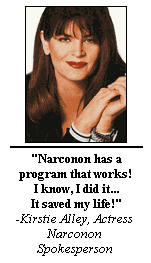
comment corner
 |
| drug rehabilitation saving taxpayers |
California taxpayers are saving more money than expected due to ... |
 |
| Study: Marijuana Causes Lung Damage |
New research finds that smoking three or four marijuana cigarettes ... |
 |
| Thanks to Online Pharmacies, Addiction Can Be Just a Click Away |
WASHINGTON -- Kelly Knable, a 34-year-old mother of three from ... |
 |
| Balancing pain and drug addiction |
Over the past two decades, two conflicting medical ideas have ... |
 |
| Clean break |
... |
 |
| State officials create prescription drug abuse task force |
TALLAHASSEE, Fla. -- State officials on Friday announced the creation ... |
 |
| Florida system often fails to catch Medicaid abuse at source |
FORT LAUDERDALE, Fla. - (KRT) - The victim's skin was ... |
 |
| Marijuana's rising threat: For more kids, use turns into addiction |
John Brown experimented with marijuana at age 10, and it ... |
 |
| Student gets state prison term for selling marijuana |
EASTON -- David Messina had his whole life ahead of ... |
 |
| Man charged in cocaine case forfeits $585,000 |
An Iowa truck driver arrested by Kentucky Vehicle Enforcement officers ... |
 |
| Cocaine Curtails Body's Ability to Cool Off |
In addition to triggering life-threatening cardiovascular episodes, cocaine can be ... |
 |
| Science for Cops |
I admit it: I'm a Law & Order fan. ... |
 |
| New Gene Therapy Could Help Quell Alcoholic Cravings |
One prevailing view of addiction holds that alcohol and other ... |
 |
| One Dose of Cocaine Primes the Brain for Addiction |
It isn't a myth: one dose of cocaine is all ... |
 |
| Marijuana Firmly Linked to Infertility |
Scientists from the University of Buffalo have smoked out what ... |
 |
| Moderate Alcohol Consumption Clouds Brain's Ability to Detect Mistakes |
It's common knowledge that a brain on booze doesn't function ... |
|
Narconon Pictures |
|
 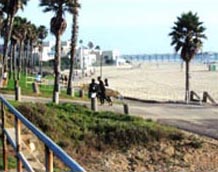 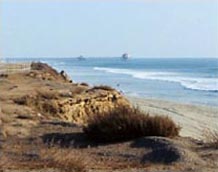 |
|